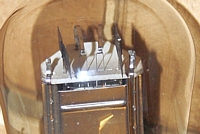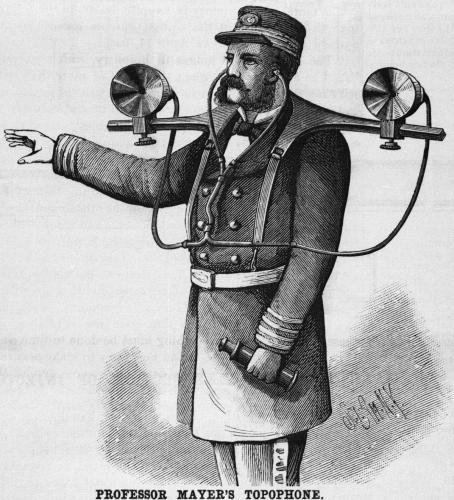Portrait of a Tube
Ca / PTT3 / 1802
Some variations of this tube exist, with or without a shield connection, some are sprayed with bronze paint, and some have the grid at another pin. For the rest they are all the same.
Designations
First, there is the "S" version of those. This version has a copper wire ring inside the socket, which acts as a shield. Or, there is a conductive paint at the glass, for the same purpose. The shield is connected to the pin M, and it should be grounded, or left open. For the rest, there is no difference with the none-S Version. I think for HiFi, the screen is useful too, but not very important. The only thing to take care of, when buying these tubes are replacement, is the connection of the grid. See the next text part.
Strange Pin Connections of PTT3.
For unclear reasons, the PTT3 has the he Grid at pin4, and Shield at Pin3. Normally, like with Ca, Cas and 18028 the Grid is at pin3, and the shield at Pin4.
The Ca / Cas / 18028 is the more common type, if you ask me. So keep the different connection scheme of PTT3 in mind, you can not use it to replace Ca / Cas / 18028, without re-wire the socket.
The Use
I think the Philips 18028 gives the best hint for the intended use, it was made by a department called "Philips Transmission". So we must probably think of telephone transmission applications. In any case, the tube has a linearity, so beautiful, you do not see this very often. I will try to make a curve plot later. The tube can make a very high voltage swing at low distortion. The gain I measure with 7.6, which makes it an really excellent output tube for low power, or a fantastic driver tube.
Data for testing:
Ua = 220V
Ug1= -12V
Ia = 20mA
S= 1.6mA/V, or Gm=1600
Anode Dissipation Max 5Watt.
Heater voltage 3.6V
For testing, set Ia to 20mA,by changing Ug1, and measure Gm at 20mA:
 BOTTOM view |
18028 Socket Connections - BOTTOM view Be careful with the general designation Ca-PPT3-18028, which you find mostly in the internet, and here as well. Not all of them have the grid at the same pin. 18028 is connected like on this picture here. The connection M is a copper wire ring, inside the tube base, used for static shielding. You can ground it, or leave it unconnected. |
 |
18028 uses the five pin Siemens post socket. I have a small supply of Gold plated, ceramic sockets. |
| I have to begin by telling something about the RE134, one of the nicest DHT tubes I know. Unfortunately it is practically unavailable for DIY to build amplifiers from. Radio collectors are already happy to find one good working used tube, to work in the radio. Don't ask for pairs. Ask for a matched pair is a joke, and a NOS matched pairs, the way HiFi users think they "must have", you find that less than once in a lifetime. So RE134 is the domain of the radio collectors, but I have seen people build HiFi equipment with used RE134, and also this performs very good. Linearity, efficiency, bias point, impedance, it all seems right. What amazes me most, is the low heater current. Only 150mA, which can give a linear 23mA by the tube curves, at maximum plate dissipation. However, it must be said, this 150mA heater current was chosen to use the tubes in battery radios. In the early days of radio, there was a DC mains connection to some houses of the rich, and light was made h gas or petroleum lamps. So for radio, operating it on battery way very logical. Also the plate voltage was a special battery. The RE134, is already very good in efficiency, but the pre-amp tubes belonging to it, the RE34, you will find those a miracle of efficiency, running very good on a little as 60mA heater current. However, I use the saying there is no replacement for heater power. So in the end, the higher the heater power, the better the tube is going to work. Better in terms of linearity, efficiency, and lifetime. All things become better. So it should be no surprise the 18028 is outdoing the RE134, because it has higher heater current. | |
 |
RE134 has the anodes in horizontal plane. As you can see a little bit in the above picture. This was just a way to build the tube without mica, and it kept also the material of the "Barium pill" away from the tube base, while activating the tube. |
 Jacmusic Order Nr: 114-163-67 |
So.... it there another tube like RE134? The answer is: YES, there is. It is the Ca (German post), PTT3 (French Post) and the 18028 (By Philips). The German tube dealer RSD in Germany, was offering a re-based version of 18028, and called it RE134S. WIth "S" meaning "Special", which was the usual designation for re-based tubes. 18028 was a made by Philips, used by the post in telephone amplifiers. Though I failed to find a datasheet of the 18028, it appears to be very similar to Ca and PPT3, of which datasheets do exists. Note: 18028 has a 3.6 Volts 1,1 Ampere heater, and RE134 is 4Volt 150mA. Apart from that, and the socket, 18028 is a direct replacement for RE134. Furthermore, dissipation of 18028 is 5 Watt, vs RE134 is maximum 3Watt. So it is upwards compatible. This is possible by the higher heater current of 18028. |
 |
RE134 has a damped barium layer, a very thin layer, coming from the Barium Pill which was on the inside of the anode, and activated after the bulb is closed. This is a simple and efficient technology, but not very high lifetime, as Barium depot of course is small. 18028 has the later technology Oxide coated filaments, like DHT are still made today. This uses some more heater current, but the technology offers higher peak emission, more convenient tube activation, and no risk of Barium spread inside. 18028 has the anodes in a vertical plane, like later tube always had. So also the problem of filament wire sagging is gone. Anode and heater construction show great similarity with early radio tubes from the USA, like the 30. Though electrical data of the 18028 is like Telefunken RE134. |
 |
The 45 tubes with balloon (Globe) glass is very expensive. A globe tube is one with the internal system not connected to the glass. This was is a very good method to achieve lowest microphonics. So any mechanical movement of the anode can only be done via the two anode rods, that mount the anode to the socket. Any acoustical contact from the glass directly to the tube system is impossible because inside in vacuum. The glass bulb is the typical Valvo / Siemens "2R" glass. 2R is pronounced "two radius". I don't want to mystify this, but it is kind of difficult to have resonances in such a glass shape. (Similar to C37 ® glass by violin builder Dieter Ennemoser) |
 |
Original Boxes from the second world war. Most have date code 1945 and VALVO Hamburg stamped on the box. These are identical to the RT France PTT3, that is sure as can be. Specially with the typical VALVO 2R Glass on these tubes, and the Valvo boxes, it seems to me the so called "RT FRANCE" PTT3 was made by Valvo as well.
|
 Click here for full Size |
PTT3 datasheets copy from the Piotr Bible.As an output tube, you can get 1.5 Watt out of it. You can use a SE output transformers made for the 45 tube. Another idea would be a PSE amplifier, using two 18028 per channel. That brings the tube impedance down to 2200 Ohms, and you can use a transformer from the 2A3 tube. This results in maximum 3 Watt per channel. A good application would be a driver tube. It can produce enough AC signal even to drive tubes likes 2A3 or 300B. Another application is a an output tube of a pre amplifier. Very nice is the relative good gain of 9x. So when you reduce the output voltage, with an output transformer, say a factor 6, you get an output impedance of appr 125 Ohms, and a total gain of the pre amp still of 1.5x. Very nice! |
 |
From what went on during the war, there is no reliable information presented, today any more. So we do have some unknown tubes, without datasheets Still this shows once more the close relation between Philips and Valvo Hamburg, as we know from before and after the war too This Excel file with measurements, and all tube data in it, shows that Ca, PTT3, and 18028 have the same behavior. Thanks Aaron Karmelk for this Excel file about the 18028 and PTT3 |
 |
It tests identical to RE134. Gain, Bias, transconductance, plate impedance, and tube curves, it is all the same. This makes it possible to use a tube tester that can do Ca. |
|
The Boxed anode of the 18028 is the source for higher gain, combined with superb linearity still. |
So.... How to use it as an output tube? Well, that we have to reconstruct ourself. From the Ca datasheet you can see this tube was used by the post office as a pre amplifier tube or driver tube, which is logical because the post needs to amplify telephone signals at low noise and low distortion, and not drive loudspeakers with it. Remember though, 18028 is also a big RE134, and that is a typical output tube indeed, so use of the 18028 will work very nice! There is just no datasheet for the 18028, and all we have is the recommended pre-amplifier use from the Ca datasheet. However, we are very close already when we use the Ca tube curves. The heater dissipation of 4 Watt is very high, and using a factor two, we have a plate dissipation of 8 Watt already. Compare this with the 45 tube, it has 3.75 Watt heater dissipation and 11 Watt plate dissipation. The 2A3 has 6,25 Watt heater, and 15 Watt plate. You always find a factor two or higher. Yet we will not overdo, and we use the 18028 at 6.5 Watt. So only a 1.6 factor, which seems very safe. From doing some constructions with the plate curves, I have found following operating point, in auto bias. Ua = 320V
|
 |
|

